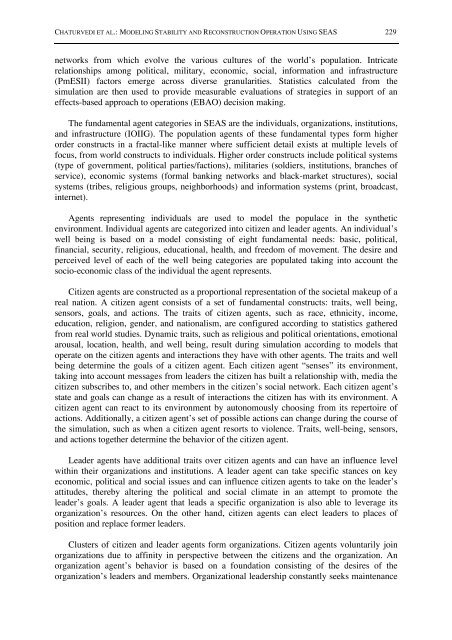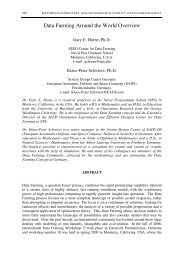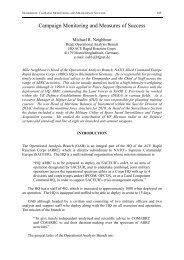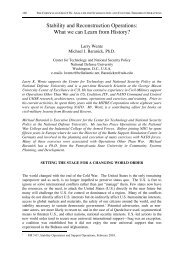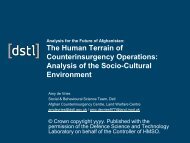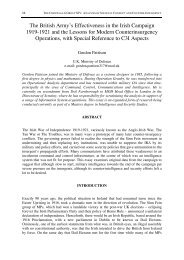Modeling Stability and Reconstruction Operation ... - Cornwallis Group
Modeling Stability and Reconstruction Operation ... - Cornwallis Group
Modeling Stability and Reconstruction Operation ... - Cornwallis Group
You also want an ePaper? Increase the reach of your titles
YUMPU automatically turns print PDFs into web optimized ePapers that Google loves.
CHATURVEDI ET AL.: MODELING STABILITY AND RECONSTRUCTION OPERATION USING SEAS 229networks from which evolve the various cultures of the world’s population. Intricaterelationships among political, military, economic, social, information <strong>and</strong> infrastructure(PmESII) factors emerge across diverse granularities. Statistics calculated from thesimulation are then used to provide measurable evaluations of strategies in support of aneffects-based approach to operations (EBAO) decision making.The fundamental agent categories in SEAS are the individuals, organizations, institutions,<strong>and</strong> infrastructure (IOIIG). The population agents of these fundamental types form higherorder constructs in a fractal-like manner where sufficient detail exists at multiple levels offocus, from world constructs to individuals. Higher order constructs include political systems(type of government, political parties/factions), militaries (soldiers, institutions, branches ofservice), economic systems (formal banking networks <strong>and</strong> black-market structures), socialsystems (tribes, religious groups, neighborhoods) <strong>and</strong> information systems (print, broadcast,internet).Agents representing individuals are used to model the populace in the syntheticenvironment. Individual agents are categorized into citizen <strong>and</strong> leader agents. An individual’swell being is based on a model consisting of eight fundamental needs: basic, political,financial, security, religious, educational, health, <strong>and</strong> freedom of movement. The desire <strong>and</strong>perceived level of each of the well being categories are populated taking into account thesocio-economic class of the individual the agent represents.Citizen agents are constructed as a proportional representation of the societal makeup of areal nation. A citizen agent consists of a set of fundamental constructs: traits, well being,sensors, goals, <strong>and</strong> actions. The traits of citizen agents, such as race, ethnicity, income,education, religion, gender, <strong>and</strong> nationalism, are configured according to statistics gatheredfrom real world studies. Dynamic traits, such as religious <strong>and</strong> political orientations, emotionalarousal, location, health, <strong>and</strong> well being, result during simulation according to models thatoperate on the citizen agents <strong>and</strong> interactions they have with other agents. The traits <strong>and</strong> wellbeing determine the goals of a citizen agent. Each citizen agent “senses” its environment,taking into account messages from leaders the citizen has built a relationship with, media thecitizen subscribes to, <strong>and</strong> other members in the citizen’s social network. Each citizen agent’sstate <strong>and</strong> goals can change as a result of interactions the citizen has with its environment. Acitizen agent can react to its environment by autonomously choosing from its repertoire ofactions. Additionally, a citizen agent’s set of possible actions can change during the course ofthe simulation, such as when a citizen agent resorts to violence. Traits, well-being, sensors,<strong>and</strong> actions together determine the behavior of the citizen agent.Leader agents have additional traits over citizen agents <strong>and</strong> can have an influence levelwithin their organizations <strong>and</strong> institutions. A leader agent can take specific stances on keyeconomic, political <strong>and</strong> social issues <strong>and</strong> can influence citizen agents to take on the leader’sattitudes, thereby altering the political <strong>and</strong> social climate in an attempt to promote theleader’s goals. A leader agent that leads a specific organization is also able to leverage itsorganization’s resources. On the other h<strong>and</strong>, citizen agents can elect leaders to places ofposition <strong>and</strong> replace former leaders.Clusters of citizen <strong>and</strong> leader agents form organizations. Citizen agents voluntarily joinorganizations due to affinity in perspective between the citizens <strong>and</strong> the organization. Anorganization agent’s behavior is based on a foundation consisting of the desires of theorganization’s leaders <strong>and</strong> members. Organizational leadership constantly seeks maintenance


